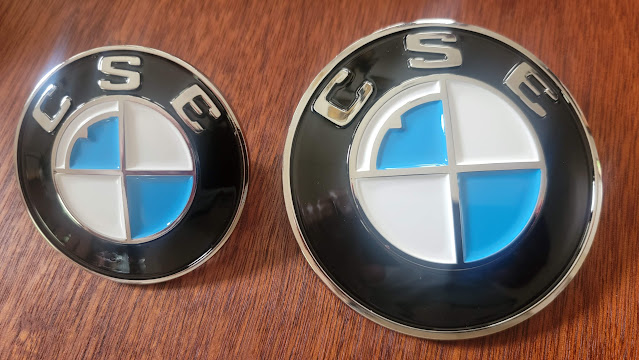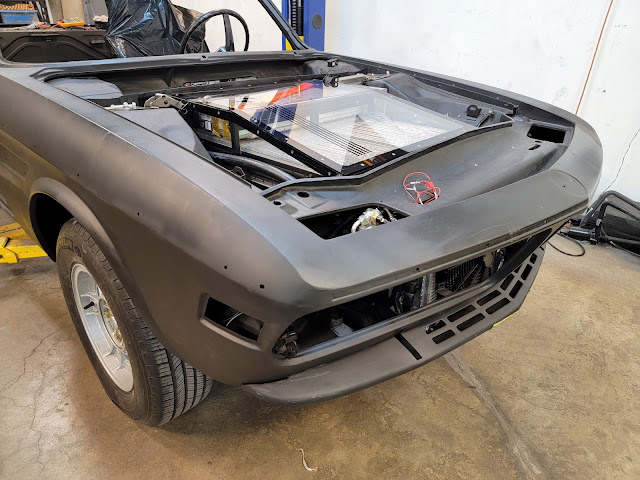FAQ
- Why ruin a perfectly nice old BMW by converting it to electric?
I already own a number of classic gas engined cars and I wanted to do something unique. Also, electric cars are more pleasant to drive (quieter, cooler, quicker) and those pleasant driving characteristics seem to suit the elegant styling of the E9 coupe well. Also, I love the challenge of design, fabrication, programming, and general problem solving involved with this project. I didn't need another car. I needed a new project. - Can you undo it back to stock later?
Nope. No way, no how. In order to mount the Tesla drive unit, I had to cut out the entire trunk area, weld in re-enforcements, and generally cut and modify the chassis all over. There were over 30,000 E9 coupes produced from 1968-1975 and, because they've always been so expensive and pretty, many have survived. My original car wasn't a CSL, a CSi, or anything particularly special -- it was a 1973 USA model 3.0 CS with an automatic transmission. It was begging for upgrades no matter what. I have no qualms with forever modifying my car. I'll leave the preservation to the owners of the more "special" variants.
There's no going back now. - Are you really using Tesla parts?
Yes, in many areas. I have a complete Tesla base-level Model S Drive Unit (motor, inverter, differential), 14 Tesla Model S battery modules, Tesla electric A/C compressor, and a Tesla iBooster brake system in my car. While it is possible to use other Tesla parts, such as the DC/DC converter, on-board charger, parking brake calipers, etc. I am using 3rd party or original BMW parts in those areas. The goal isn't to try to build my own Tesla but to modernize a beautiful classic car while keeping its vintage looks and heritage so I'm not putting in big Tesla touch screen displays or pop-out door handles, etc.
The Tesla part number and serial number on my drive unit - Where do you get Tesla parts?
From wrecked Teslas. But I didn't go to a junkyard and salvage my own parts. There are specialists who harvest parts from wrecked cars and test them to assure they are not damaged. I purchased my drive unit, batteries, and axles from Jason at 057 Technologies because he flashes the drive unit with new firmware that works in conjunction with a drive unit controller of his design that I then use to control the motor.

The Tesla small drive unit and Tesla Model S axles as shipped from 057 Technologies - How do you control the Tesla motor?
As mentioned above, I use the 057Tech drive unit controller. It has inputs for a drive-by-wire throttle pedal, gear selection, and a Controller Area Network (CAN bus) connection to send and receive messages and commands.

The 057 Technologies Drive Unit Controller used to control the Tesla drive unit - Where did you learn how to do all this?
Through trial and error and help from others such as Paul Dexter, Lars Rengersen, Jason Hughes, and Mike Bream. I'm not an electrical engineer or metal fabricator. I am a software developer so I've really enjoyed the programming side of things, but even that had a steep learning curve as I had never programmed the small micro controllers or micro computers before. There are a lot of ways to solve the problems encountered in these EV projects and I've made mistakes but that's where a lot of the enjoyment comes from. AEM electronics has a very good FAQ where they describe all the pieces of an EV conversion. - How much power will you have?
By using the small Tesla drive unit, my car has 294 horsepower (220kW) and 330 Nm (~243 ft/lb) of torque. Using the large Tesla drive unit (which fits just as easily but weighs almost twice as much) one could have up to 636 HP (475kW). The original 1973 BMW 3.0 CS had a 3 liter straight six cylinder gas engine that produced 180 horsepower (134 kW) and 272 Nm (201 ft/lb) of torque so I have 63% more power than when new. - Won't all that power destroy the chassis?
It's a valid concern and one of the reasons I opted for the smaller drive unit. I've strengthened the unibody chassis of the original BMW in many places in an attempt to properly handle the increased power and torque.
Welded steel chassis re-enforcement on and between rear wheel wells to support the Tesla drive unit - How much range will you have?
As always, range differs with driving characteristics but I can easily get 200 miles of driving on a single charge. My battery pack stores 71 kWh of energy. I run with aggressive regen braking most of the time, meaning that the car recharges the batteries and slows down significantly when my foot lifts off the throttle. - How long does it take to charge?
Charging time varies with input current. On a typical household 220v, 30 amp circuit it takes about 9-10 hours to fully charge the car from empty. This can be reduced to about 3 hours on a 60 amp circuit but it is easier on the batteries to charge more slowly. I use an Overtech onboard charger, not the Tesla OEM unit and I do not support fast DC-DC charging. - What does this conversion cost?
The EV parts are about $37,000. The total labor was not measured but is significant. The cost of restoration is also not factored in. It would be much more economical to just buy a Tesla. - Won't the car be heavy or weight unbalanced?
Not really. I haven't finished the car yet so I don't have an accurate measurement but a stock 3.0 CS weighs in at a fairly svelte (especially compared to today's bloated behemoths) 3,170 pounds, broken down as follows:
Front: 1743 lbs. (Drivers 916 lbs, Passenger 827 lbs.)
Rear: 1427 lbs. (Drivers 719 lbs, Passenger 708 lbs.)
Total: 3170 lbs.
Without the engine, transmission, and differential, the weight is:
Front: 1020 lbs. (Drivers 576 lbs, Passenger 444 lbs.)
Rear: 1140 lbs. (Drivers 588 lbs, Passenger 552 lbs.)
Total: 2160 lbs.
Subtracting, we learn that the stock drivetrain weighs 1,100 pounds. Now, compare that to the Tesla drivetrain:
Small Drive Unit: 194 lbs
Batteries: 770 lbs (14 modules at 55 lbs each)
Battery boxes: 40 lbs
Charger, DC/DC converter: 18 lbs
Electric water pump, hydraulic pump, A/C compressor: 30 lbs
Wiring, contactors, BMS, etc: 20 lbs
Total: 1,072 lbs
Thus, the weight is about equal. And electrons don't weigh much while a full tank of fuel weighs about 115 pounds (70 liters at 750 grams/liter). Therefore, my electric CSE might actually weigh less than a fully fueled stock 3.0 CS.
As for weight distribution, I have 10 battery modules up front and 4 in the back, along with the drive unit. This is probably pretty close to the original front/rear weight distribution. My center of gravity is probably a tiny bit higher as the iron engine block sits low and my batteries stack high. - Will it be safe?
Hopefully. I have a variety of safety measures in place. These include fuses, relays, contactors, switches, a sophisticated battery management system, etc. I wouldn't want to get in a wreck with my car, and it would certainly fail any modern crash test, but then so would the original gas engined coupe. If you want to be safe, buy a Tesla.


